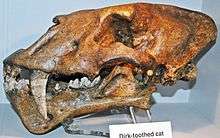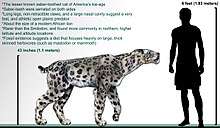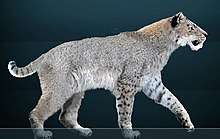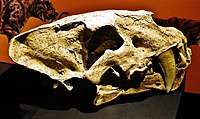Homotherium
Homotherium (also known as the scimitar-toothed cat or scimitar cat)[2] is an extinct genus of machairodontine saber-toothed cats,[3] often termed scimitar-toothed cats, that inhabited North America, South America, Eurasia, and Africa during the Pliocene and Pleistocene epochs (4 mya – 12,000 years ago), existing for approximately 4 million years.[1][4]
| Homotherium | |
|---|---|
| Skeleton of H. serum from Friesenhahn cave, Texas Memorial Museum, University of Texas at Austin, Austin, Texas. | |
| Scientific classification | |
| Kingdom: | Animalia |
| Phylum: | Chordata |
| Class: | Mammalia |
| Order: | Carnivora |
| Suborder: | Feliformia |
| Family: | Felidae |
| Subfamily: | †Machairodontinae |
| Tribe: | †Homotherini |
| Genus: | †Homotherium Fabrini, 1890 |
| Type species | |
| Homotherium latidens Owen, 1846 | |
| Other species | |
| |
It became extinct in Africa some 1.5 million years ago. The most recent Eurasian remains, recovered from what is now the North Sea, have been dated to around 28,000 years BP.[5] In South America it is only known from a few remains in the northern region (Venezuela), from the mid-Pleistocene.[6]
Taxonomy and distribution

The name Homotherium (Greek: ὁμός (homos, 'same') and θηρίον (therion, 'beast')) was proposed by Emilio Fabrini (1890), without further explanation, for a new subgenus of Machairodus, whose main distinguishing feature was the presence of a large diastema between the two inferior premolars.[7][8]
The lineage of Homotherium is estimated (based on mitochondrial DNA sequences) to have diverged from that of Smilodon about 18 million years ago.[9] Homotherium probably derived from Machairodus and appeared for the first time at the Miocene–Pliocene border, about 4 to 5 million years ago.[10] During the Pleistocene it occurred in vast parts of Eurasia, North America and until the middle Pleistocene (about 1.5 million years ago) even in Africa. A fossil of H. crenatidens was inadvertently dredged from the bed of the North Sea, which was a flat, low-lying extent of marshy tundra laced with rivers during the last glacial period.[11] There has also been a discovery of 1.8-million-year-old fossils in Venezuela,[12][13][14] indicating that scimitar-toothed cats were able to invade South America along with Smilodon during the Great American Interchange. These remains form the holotype of Homotherium venezuelensis.[6] How long they lasted in South America is not yet evident. Homotherium survived in Eurasia until about 28,000 years ago.[5]
Several Eurasian species have been recognized based mainly on differences in the size and shape of the upper canines and body size: H. latidens, H. nestianus, H. sainzelli, H. crenatidens, H. nihowanensis, and H. ultimum. However, given the range of sizes found in extant large cats, it is likely that they represent a single species, Homotherium latidens.[4]
Two species described from early Pleistocene Africa, H. ethiopicum and H. hadarensis—also hardly differ from the Eurasian forms.[10] On the African continent the genus disappeared about 1.5 million years ago. In North America a very similar species, H. serum, occurred from the late Pliocene until the late Pleistocene. However, both morphological and genetic data suggest that all late Pleistocene Homotherium individuals worldwide should probably be regarded as members of H. latidens.[9] Remains have been found at various sites between Alaska and Texas. In the southern parts of its range the American Homotherium co-existed with Smilodon; in the northern parts it was the only species of saber-toothed cat. The American Homotherium was originally described by the name Dinobastis.
Despite Homotherium's vast range and the large quantity of fossil remains from Eurasia, Africa and North America, complete skeletons of this cat are relatively rare. One of the most famous sites of Homotherium remains is Friesenhahn cave in Texas, where 30 Homotherium skeletons were found, along with hundreds of juvenile mammoths and several dire wolves.[15]
The genus Dinobastis was originally named by Cope (1893). Its type is Dinobastis serus. It was synonymized subjectively with Smilodon by Matthew (1910) and later with Homotherium by Churcher (1966), Schultz et al. (1970), Waldrop (1974), Kurtén and Anderson (1980), Churcher (1984) and Dalquest and Carpenter (1988).[16][17][18]
Description

Homotherium reached 1.1 m (3 ft 7 in) at the shoulder and weighed an estimated 190 kg (420 lb) and was therefore about the size of a male African lion.[19][20] Compared to more familiar machairodonts, like Smilodon or Megantereon, Homotherium had comparatively shorter upper canines, but these flat, serrated teeth were still longer than those of any living cat. Homotheirum's incisors and lower canines formed a powerful puncturing and gripping device; among living cats, only the tiger (Panthera tigris) has such large incisors, which aid in lifting and carrying prey. The molars of Homotherium were rather weak and not adapted for bone crushing. The skull was longer than in Smilodon and had a well-developed crest, where muscles were attached to power the lower jaw. This jaw had down-turned forward flanges to protect the scimitars. Its large canine teeth were crenulated and designed for slashing rather than purely stabbing.
Homotherium had the general appearance of a cat, but had a number of atypical features for a felid. Homotherium had unusual limb proportions, with longer, more robust forelimbs that gave it a hyena-like appearance. The hind quarters were rather squat with feet that may have been partially plantigrade, causing the back to slope towards the short tail. Features of the hind limbs indicate that this cat was moderately capable of leaping. The pelvic region, including the sacral vertebrae, was bear-like, as was the short tail composed of 13 vertebrae—about half the number of long-tailed cats'.
The unusually large, square nasal opening, similar to that of the cheetah (Acinonyx jubatus), presumably allowed faster oxygen intake, which would have aided in rapid or extended running and in cooling the brain. Again similarly to the cheetah, the visual cortex in Homotherium's brain was large and complex, implying that the scimitar cat relied heavily on vision during the hunt.
Based on Homotherium's preference for open habitat such as plains and comparisons with modern cats, it is considered likely by ethologist William Allen et al that Homotherium would have been plainly colored like lions to better camouflage itself.[21]
Diet and habitats

The decline of Homotherium could be a result of the disappearance of large herbivorous mammals like mammoths in America at the end of the Pleistocene. In North America fossil remains of Homotherium are less abundant than those of its contemporary Smilodon. For the most part it probably inhabited higher latitudes and altitudes and therefore was likely to be well adapted to the colder conditions of the mammoth steppe environment. The reduced claws, relatively slender limbs, and sloping back all appear to be adaptations for endurance running in open habitats.[22]
African Homotherium species seem to have hunted early Pleistocene species of Deinotherium, likely preferring to target the more vulnerable adolescents or calves in a herd. Due to their saber-teeth, an attack on such thick-skinned prey would have likely been significantly easier and less time-consuming compared to a similar hunt on modern elephants by lions.[23]
At the well known Friesenhahn Cave site in Texas, the remains of almost 400 juvenile mammoths were discovered along with numerous Homotherium skeletons of all ages, from elderly specimens to cubs. Based on this fossil site, Homotherium was likely a social predator that would have been specialized in hunting young mammoths and that subsequently dragged the kills into secluded caves to eat in relative peace. Homotherium also seemed to have retained the excellent nocturnal vision typical of most cats, and hunting at night in the arctic regions where many Homotherium have been found would have been a prime hunting method.[24] The sloped back and powerful lumbar section of Homotherium's vertebrae suggest a bear-like build, and thus that these animals could have been capable of pulling formidable loads; further, broken upper canines - a common injury in fossils of other machairodonts such as Machairodus and Smilodon that would have resulted from struggling with their prey - is not seen in Homotherium, perhaps because their social groups would completely restrain prey items before any of the cats attempted to kill the target with their saber teeth. Moreover, the bones of the young mammoths found in Friesenhahn Cave show distinctive marks matching the incisors of Homotherium, indicating that they could efficiently process most of the meat on a carcass and that the mammoths had been deposited in the caves by the cats themselves and not by scavengers. Examination of the bones also indicates that the carcasses of these juvenile mammoths were dismembered after being killed by the cats before being dragged away, suggesting that Homotherium would disarticulate their kill to transport it to a safe area such as a hidden lair or den and prevent competitors such as dire wolves and American lions from usurping the carcass.[25][26]
See also

References
- Antón, Mauricio. Sabertooth. Indiana University Press, 2013.
- "American Scimitar Cat". Yukon Beringia Interpretive Center. Retrieved 19 February 2018.
The scimitar cat was the second largest feline species to live in Yukon during the Ice Age (after the Beringian lion) — weighing in around 200 kilograms.
- PaleoBiology Database: Homotherium, basic info
- Turner, A. (1997). 'The big cats and their fossil relatives. Columbia University Press. ISBN 0-231-10229-1
- Reumer, J.W.F.; L. Rook; K. Van Der Borg; K. Post; D. Mol; J. De Vos (2003). "Late Pleistocene survival of the saber-toothed cat Homotherium in northwestern Europe". Journal of Vertebrate Paleontology. 23: 260. doi:10.1671/0272-4634(2003)23[260:LPSOTS]2.0.CO;2. ISSN 0272-4634.
- Rincón, A., Prevosti, F., & Parra, G. (2011). New saber-toothed cat records (Felidae: Machairodontinae) for the Pleistocene of Venezuela, and the Great American Biotic Interchange Journal of Vertebrate Paleontology, 31 (2), 468-478 DOI: 10.1080/02724634.2011.550366
- Fabrini, E. (1890). ""I Machairodus (Meganthereon) del Val d'Arno superiore"". Bollettino Comitato Geologico d'Italia. 21: 121–144, 161–177, esp. 176.
- R. L. (1891). "III.—Dr. E. Fabrini on Machærodus - Machærodus (Meganthereon) del Valdarno Superiore, Memoria del Dott. Emilio Fabrini (Boll. R. Com. Geol. 1890 Nos. 3–6, pp. 43, pls. 3.)". Geological Magazine. 8 (2): 82. doi:10.1017/S0016756800185498.
- Paijmans, J. L. A.; Barnett, R.; Gilbert, M. T. P.; Zepeda-Mendoza, M. L.; Reumer, J. W. F.; de Vos, J.; Zazula, G.; Nagel, D.; Baryshnikov, G. F.; Leonard, J. A.; Rohland, N.; Westbury, M. V.; Barlow, A.; Hofreiter, M. (2017-10-19). "Evolutionary History of Saber-Toothed Cats Based on Ancient Mitogenomics". Current Biology. 27 (21): 3330–3336.e5. doi:10.1016/j.cub.2017.09.033. PMID 29056454.
- Alan Turner: "The Evolution of the guild of larger terrestrial carnivores during the Plio-Pleistocene in Africa". Geobios, no 23, fasc. 3, p. 349-368, 1990.
- (BBC News) Paul Rincon, "Big cat fossil found in North Sea", 18 November 2008 accessed 18 November 2008
- Sanchez, Fabiola (2008-08-21). "Saber-toothed Cat Fossils Discovered". Associated Press. Retrieved 2017-10-20.
- Orozco, José (2008-08-22). "Sabertooth Cousin Found in Venezuela Tar Pit -- A First". National Geographic News. National Geographic Society. Retrieved 2008-08-30.
- Rincón, A. D.; Prevosti, F. J.; Parra, G. E. (2011-03-21). "New saber-toothed cat records (Felidae: Machairodontinae) for the Pleistocene of Venezuela, and the Great American Biotic Interchange". Journal of Vertebrate Paleontology. 31 (2): 468–478. doi:10.1080/02724634.2011.550366.
- Rawn-Schatzinger, V. (1992). "The scimitar cat H. serum (Cope)". Report of Investigations (47): 1–80.
- W. D. Matthew. 1910. Bulletin of the American Museum of Natural History 28
- C. B. Schultz et al. 1970. Bulletin of the Nebraska State Museum 9
- W. W. Dalquest and R. M. Carpenter. 1988. Occasional Papers, Museum, Texas Tech University 124
- Sorkin, B. 2008: A biomechanical constraint on body mass in terrestrial mammalian predators. Lethaia, Vol. 41, pp. 333–347
- Meade, G.E. 1961: The saber-toothed cat Dinobastis serus. Bulletin of the Texas Memorial Museum 2(II), 23–60.
- Switek, Brian. "Did Saber Cats Have Spotted and Striped Coats?". scientificamerican.com. Retrieved 23 April 2018.
- M. Anton et al.: Co-existence of scimitar-toothed cats, lions and hominins in the European Pleistocene. Implications of the post-cranial anatomy of Homotherium latidens (Owen) for comparative palaeoecology. Quaternary Science Reviews 24 (2004).
- "Deinotheres for lunch? A sabertooth's tough-skinned diet". 2017-03-23.
- Metcalfe, Jessica Z. "Late Pleistocene Climate and Proboscidean Paleoecology".
- "The Diet of Saber-Toothed Cats". 2008-03-07.
- Antón, Mauricio (2013). Sabertooth. Bloomington, Indiana: University of Indiana Press. pp. 227–228. ISBN 9780253010421.
External links
| Wikispecies has information related to Homotherium |
- The saber-toothed cat of the North Sea, 2008, accessed 10/28/2019
- American Scimitar Cat
- Saber-toothed cat jaw
- South America gets two more sabercats
